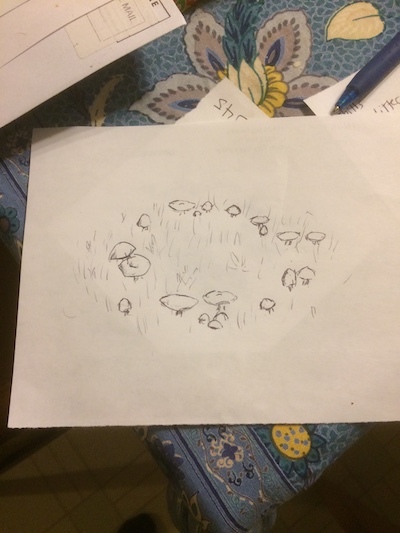Two remarkable (longish) short stories
Dec. 5th, 2024 01:37 pmI don't read half as much as I'd like to, but now and then things spur me to read something and then wow! Amazed and delighted.
The first is a novelette in the December 2024 issue of Clarkesworld: "Lucie Loves Neutrons and the Good Samarium," by Thoraiya Dyer. It's an intimate story about a lesbian couple, Lucie and Izzy, both scientists (respectively from Tahiti and Australia, but living in France), and Miron Król, the Polish astronaut who fathers their baby. A nuclear war is going on in Europe, and where they live is dangerous because of its proximity to a research reactor (a research reactor that Izzy uses, in fact), and Izzy is nearly breaking from the mental strain:
And then Lucie does.
She does it. I don't think that's a spoiler because the drama of the novelette is not the in if, it's in the how, the many small moments, some funny, some painful, some joyous, as the characters live life, do their various researches ... and Lucie comes closer and closer to being able to keep her promise. Now there's a case of writing the change you want to see in the world! From Thoraiya Dyer's imagination to reality, please!
The second is probably also a novelette--it's "The Speech That God Understands," by Jonathan Edelstein, from the April 4, 2024, issue of Beneath Ceaseless Skies. This one takes place in 1194, in an alternative Tuluz, where Muslims, Christians, and Jews live and work together, where magic and science exist side by side, and Avram the Blind, a Kabbalistic magician, and Maryam of Wadan, a Berber scientist and a nonbeliever in any religion, join forces to deal with spreading incidences of people having their ability to speak scholarly languages essentially knocked out of them--they lose their Arabic, their Latin, their Hebrew and are left with their vernacular tongues only. But it's not just a physical brain injury, there's magic involved.
There's *so* much richness in this--Avram's summoning of various sefirot, the depiction of the hurly-burly of the city, and the discussion of language, translation, and reading--just great. I can share these beautiful lines from the end without spoiling anything:
The first is a novelette in the December 2024 issue of Clarkesworld: "Lucie Loves Neutrons and the Good Samarium," by Thoraiya Dyer. It's an intimate story about a lesbian couple, Lucie and Izzy, both scientists (respectively from Tahiti and Australia, but living in France), and Miron Król, the Polish astronaut who fathers their baby. A nuclear war is going on in Europe, and where they live is dangerous because of its proximity to a research reactor (a research reactor that Izzy uses, in fact), and Izzy is nearly breaking from the mental strain:
In that moment, alerts [of possible nuclear strike] go off on their phones, and Izzy is overwhelmed. A new life has come into the world, Izzy and Lucie have just met their beautiful baby, and there is a fucking amber alert yet again, threatening to take everything away.
Izzy throws her phone at the wall.
“I can’t take this,” she screams. “Why can’t anybody make it stop?” She knows she shouldn’t be the one losing control. Lucie has just given birth ...
“Izzy,” Lucie says softly. “Izzy, I’ll make it stop. For you, and for Luc, I’ll make it stop. I promise. Now, forget about that. Come here, and kiss your child. It’s his birthday.”
And then Lucie does.
She does it. I don't think that's a spoiler because the drama of the novelette is not the in if, it's in the how, the many small moments, some funny, some painful, some joyous, as the characters live life, do their various researches ... and Lucie comes closer and closer to being able to keep her promise. Now there's a case of writing the change you want to see in the world! From Thoraiya Dyer's imagination to reality, please!
The second is probably also a novelette--it's "The Speech That God Understands," by Jonathan Edelstein, from the April 4, 2024, issue of Beneath Ceaseless Skies. This one takes place in 1194, in an alternative Tuluz, where Muslims, Christians, and Jews live and work together, where magic and science exist side by side, and Avram the Blind, a Kabbalistic magician, and Maryam of Wadan, a Berber scientist and a nonbeliever in any religion, join forces to deal with spreading incidences of people having their ability to speak scholarly languages essentially knocked out of them--they lose their Arabic, their Latin, their Hebrew and are left with their vernacular tongues only. But it's not just a physical brain injury, there's magic involved.
There's *so* much richness in this--Avram's summoning of various sefirot, the depiction of the hurly-burly of the city, and the discussion of language, translation, and reading--just great. I can share these beautiful lines from the end without spoiling anything:
From the silence, [Avram] conjured a vision of what Maryam might see if she found her reading-stone, a mental image of the night sky of Yetzirah. Who was it who’d said there were many more stars in heaven than human eyes could see? One of the Persian philosophers, or one of their poets? Did it even make a difference?
Those stars, as much as the sefirot, were outpourings of the divine, and messages were surely written in them. Isaac wondered what language those scriptures would follow. Or maybe they would be like the speech of the crickets, written in no language at all.
It didn’t matter, he decided. God would know them even so.



















